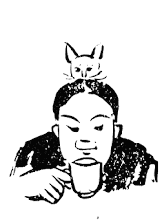Semiotic “Fishnet” and Sensuous Acquaintance/ 符号之“网”与感性之“鱼”
William M. Ivins, Jr., Prints and Visual Communication (New York: Da Capo Press, 1969), 53, 59, 63.
(Excerpted passages. Subtitles are my own.)
The Net
The only way that anyone can gain acquaintance which objects, as distinguished from knowledge of them, is through immediate sense awareness of them. It is thus necessary to keep clear the distinction between sensuous acquaintance on the one hand and knowledge by description on the other, for otherwise we are certain to fool ourselves on crucial occasions. We have many different ways of symbolizing both acquaintance and knowledge, but of them all the most important are words and visual images. Both words and visual images may very well be compared to fish nets. When a fisherman tells us that there are no fish in the bay today, what he really means is that he has been unable to catch any in his net—which is quite a different thing. The fish that are too big do not get into his net, and those that are too small simply swim through it and get away. So far as the fisherman is concerned fish are only such creatures as he can catch in his net. In the same way words and visual images catch only the things or qualities they are adequately meshed for. Among the things no word net can ever catch is the personality of objects which we know by acquaintance.
The Classification Problem
The actual object always has something about it that defies neat classification, unless you can manage always to stay in the middle of your definition and not get out towards its shadowy and slippery edges. In other words, our verbal definitions are only good so long as we do not have to think just what they mean. When we do have to think just what they mean we are more than apt to wind up with a very temperamental and wholly chance
The Syntax
Plato’s Ideas and Aristotle’s forms, essences, and definitions, are specimens of this transference of reality from the object to the exactly repeatable and therefore seemingly permanent verbal formula. An essence, in fact, is not part of the object but part of its definition. Also, I believe, the well-known notions of substance and attributable qualities can be derived from this operational dependence upon exactly repeatable verbal descriptions and definitions—for the very linear order in which words have to be used results in a syntactical time order analysis of qualities that actually are simultaneous and so intermingled and interrelated that no quality can be removed from one of the bundles of qualities we call objects without changing both it and all the other qualities. After all, a quality is only a quality of a group of other qualities, and if you change anyone of the group they all necessarily change. Whatever the situation may be from the point of view of a verbalist analysis, from the point of view of visual awarenesses of the kind that have to be used in an art museum the object is a unity that cannot be broken down into separate qualities without becoming merely a collection of abstractions that have only conceptual existence and no actuality. In a funny way words and their necessary linear syntactical order forbid us to describe objects and compel us to use very poor and inadequate lists of theoretical ingredients in the manner exemplified more concretely by the ordinary cook book recipes.


2 条评论:
I inclination not concur on it. I regard as warm-hearted post. Expressly the title-deed attracted me to study the sound story.
Good fill someone in on and this post helped me alot in my college assignement. Say thank you you for your information.
发表评论